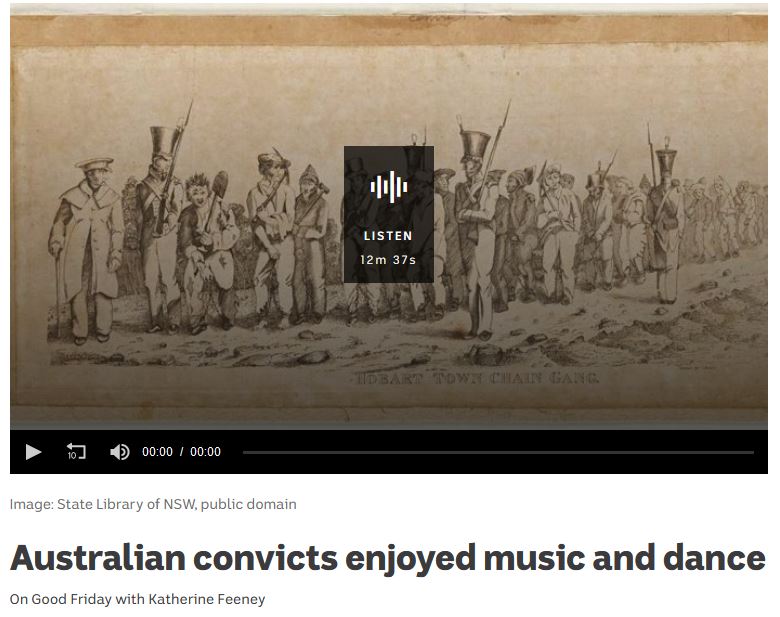 This doctoral project was undertaken at the Queensland University of Technology to research convict culture in the early colony from 1788 to 1840. The main focus concentrated on social dance with the research uncovering a surprising amount of information proving that dance was a significant aspect of convict life.
This doctoral project was undertaken at the Queensland University of Technology to research convict culture in the early colony from 1788 to 1840. The main focus concentrated on social dance with the research uncovering a surprising amount of information proving that dance was a significant aspect of convict life.
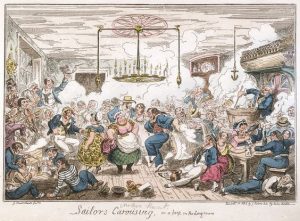
Although there are no pictures of convicts dancing in Australia, it has been possible to locate pictures of common people dancing. This picture shows dancing in an English dockside pub. National Maritime Museum, Greenwich, London.
One of the aims of historical research is to provide new perceptions and illuminating insights. The notion of convicts having a life which included music and dance is strikingly at odds with the prevailing image of convict heritage. Historians were aware that vernacular culture had quickly become established and then flourished in the English penal colony in Australia, but little was known about the details.
Dance was an integral part of everyday life in the ‘lower orders’ and one of the most popular forms of recreation in the early colony. Convicts danced to escape the drudgery and harshness of their existence; it provided social cohesion, a sense of belonging and a cultural identity in a strange, new land. They were encouraged to dance on the long voyage to the colony for their good health and some danced to the music of their jangling chains. In the settlement the authorities commented on their rowdy, disorderly dancing in the proliferation of public houses. Even in punishment convicts referred to dance, where the treadmill became known as the ‘dance academy’, and on the hangman’s noose, in their death throes, the condemned were said to dance the ‘gallows jig’. This research offers a range of unexpected perspectives on the cultural life of early Australian convicts.
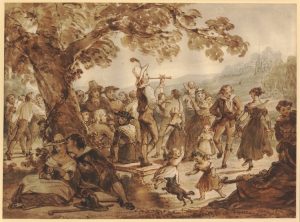
In the late 1700s and early 1800s dance was an important element of social life for all levels of society. This picture shows a village dance with one couple dancing, though dancing was also an inclusive group activity. A Village Dance by John Partridge. Courtesy of The British Museum
The purpose of the project was to locate specific information about dance and its accompanying music in the early colony, covering the period between settlement in 1788 and the abolition of transportation in 1840. The initial phase of the research developed a comprehensive database, bringing together the scattered and fragmentary evidence into a readily accessible form (still under development). Researching the background of dances of the period encompassed an overview of dance in Great Britain where the majority of convicts originated. This in itself necessitated considerable research as literature about social dance for common people in this time period is scarce.
On route to the colony, the surgeons in charge of convicts often encouraged dancing as a healthy activity and this is documented in their medical journals. In the colony the main source of information came from police reports where, although dancing itself was not illegal, many of the surrounding activities were: primarily attendance in unlicensed premises, being drunk and disorderly, and being out with permission or after curfew.
The second stage of the research translated the evidence in the database into a series of dance workshops which brought the music and dance to life. The result of this meticulous research has produced an extensive, in-depth body of data to reveal a surprisingly detailed image of the popular culture for convicts and common people in the early colony.
ABC radio
Interview with Katherine Feeney. Click here to listen
QUT media release
(click here for the full article)
Sounds Heritage at Elizabeth Bay House
Video presentation from Sounds Heritage at Elizabeth Bay House, Sydney (28 March 2017) Dancing in Fetters: the culture of convict dance
Link
This culture was the foundation of the Australian bush/folk tradition.
Bushtraditions.org is one of the main sites for promoting this music and has an extensive wiki site Australian Traditional Music Archive. A collection of convict tunes will ultimately be incorporated into the archive.
BLOG
October 2017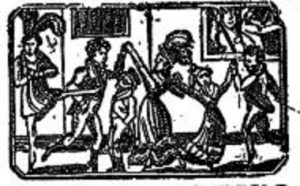
The latest research has focused on the dances and music discovered to have been popular with the convicts. One detailed account actually lists the dances which were part of the popular culture at a “two-penny hop shops” in the Rocks area of Sydney. The music for the dancing was supplied by a convict from Norfolk, England who played the flageolet aka tin whistle. The tunes quoted in this account had accompanying dances which had been published in Dublin in the 1810s. In September, this information was used in a series of workshops to explore, improvise and re-imagine these dances. The workshops were filmed and a vignette will be produced to capture the essence of the dance.
The next step in the process is analysing, interpreting, and evaluating the findings. The conceptual framework for this is supplied by Adshead-Lansdale, J. (1988). Dance analysis: theory and practice. London: Dance Books.
March 2017
Over the last six months I’ve compiled a comprehensive database of convict dance material. I’ve been surprised at the amount of data that has accumulated. I’ve also been puzzled at the lack of research, anywhere in the world, regarding dance for the lower echelons of society. The majority of historical dance research focuses on the elite forms of dance – the court, theatre, and ballet. As an ephemeral art, dance has been difficult to research and has not been regarded as a serious academic field of study. With the advent of internet the number of sources for this type of research has increased astronomically and I’ve been able to locate information never before accessible.
The database contains information from a large variety of sources: Old Bailey Court Proceedings, Police Incidents, Government Reports, pictures and paintings, diaries, letters and contemporary literature. All this information will be used in the final stage of the research to revive the dances in a series of workshops which will be filmed and added to the database. Ultimately, this database will be developed as an online resource.
August 2016
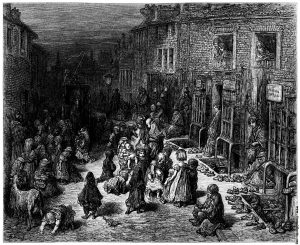
Dudley Street, Seven Dials by Gustave Doré. This slum in the heart of London reveals the poverty and crowded conditions common in poor working class areas.
Gustave Doré’s images of the the slums and poverty of London lead me to consider if those writing about the horrors of the convict experience in Australia had ever ventured into these squalid areas.
“In 1869, French artist Gustave Doré began an extraordinary collaboration with the British journalist Blanchard Jerrold. Together, over four years, they produced a landmark account of the deprivation and squalor of mid-Victorian London.”
This account was produced after transportation to Australia had ceased.
Research Trip: May-June-July-August 2016
Research trip in Britain and Ireland. A great opportunity to visit libraries and dance festivals, and discuss the research with other interested dancers and academics. I’ve gained some very valuable insights. Here’s the listing of places and events:
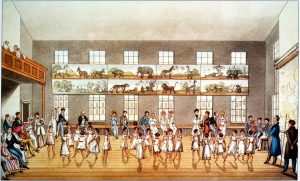
We danced in this building at New Lanark where the children of the factory workers were taught music and dance in the early 19th century. Robert Owen established an ‘ideal’ community for his workers and instituted a wide range of workplace, social, and educational reforms. Now a World Heritage Site, it’s an amazing place to visit.
Libraries: British Library, Caird Library -National Maritime Museum, Vaughan Williams Library – Cecil Sharp House, Cambridge University Library & Pendlebury Library of Music, Perth & Kinross Library, National Library of Ireland, meeting at the Irish World Academy of Music and Dance in Limerick University, Kennedy Grant Library at Halsway Manor.
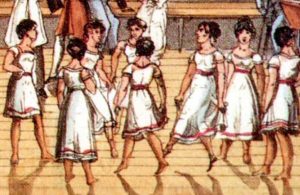
Owen considered dance and music to be important aspects of education. Both boys and girls danced in tunics. Image courtesy of New Lanark World Heritage Site.
Festivals, dance weeks, and balls: Eastbourne International Folkdance Festival, Chippenham Folk Festival, 44th Stonesfield Dance Weekend, Lichfield Folk Dance Festival, Nicholas Broadbridge’s Purcell Ball at New Lanark, Yorkshire Folk Dance Weekend, Skipton Clogfest, Retford Playford Ball, Summer Days dance week at Halsway Manor, Sidmouth Folk Festival, Dartmoor Folk Festival.
Clubs & dances: May morning with Long Man Morris Men (spouse’s former side), Chingford Folk Dance Club, St Albans Friday Folk Club, St Albans Dance, Mrs Bennett’s Ballroom, The Quadrille Club, Knaresborough Country Dance Club, Ceilidh at a family wedding in Durham, Royal Scottish Country Dance (Perth Branch) at Scone.
Most useful resource for planning the trip was Set and Turn Single: the listing site for folk dancers in England. www.setandturnsingle.org.uk
Trends in country dancing: Dance leaders are looking again at the Cecil Sharp versions of Playford’s English country dances and re-interpreting them in the light of greater understanding from historical sources. There is some encouragement to use dance steps rather than simply walking: this isn’t a new concept having been advocated for some time by Ann Daye of the Historical Dance Society, and Kate van Winkle Keller in If the Company Can do it (1991), however, the idea does seem to be gaining momentum. I found the ‘Zesty’ Playford movement disappointing: although I thoroughly agree that these dances should be danced with energy, it appeared that only the simplest dances were presented, resulting in a ‘dumbing down’ of the dance form.
Highlights: Discovering traditional step dancing in the south of England which is extremely relevant to our Australian research, and has fascinating convict connections.
March 2016 – Typecasting convicts
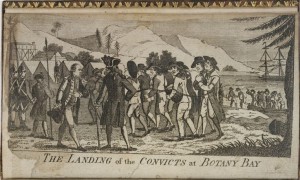
Landing of convicts at Botany Bay. Engraving from Watkin Tench’s book, A Narrative of the Expedition to Botany Bay (1789). Dixson Library, State Library of New South Wales
Exploring the stereotyping of convicts which so influences our vision of early colonial society. Much has been written about this in the last few years. The idea that all convicts were brutalized and oppressed, when in fact the majority probably lead quite normal lives. The convict experience has been hugely misrepresented, especially in popular works such as Marcus Clarke’s For the Term of His Natural Life and Robert Hughes’ The Fatal Shore. This image has been completely overturned with the critical research of modern historians.
Excellent resources include:
Daniels, K. (1998). Convict women. St. Leonards, N.S.W: Allen & Unwin.
Frost, A. (2012). Botany Bay: the real story (Vol. 2nd). Collingwood, Vic: Black.
Hirst, J. (2008). Freedom on the Fatal Shore. Australia’s First Colony. Melbourne: Black Inc.
Karskens, G. (2009). The colony : a history of early Sydney / Grace Karskens. Crows Nest, N.S.W: Allen & Unwin.
McClaughlin, T. (1998). Irish women in colonial Australia. St Leonards, N.S.W: Allen & Unwin.
February 2016 – Old Bailey court proceedings
A surprising source of information about dance and its role in society. Not the elite, fashionable society, but the everyday life of ordinary people. This account by the Ordinary (chaplain) at Newgate provides a touching insight into the life of a man condemned to be executed at Tyburn, on Monday the 31st of December, 1722.
….he got to be a Drawer of Ale at Sadler’s-Wells; upon which, he thought he was at once leapt into that Life of Pleasure, which he had so long retain’d in his Fancy: For the Thoughts of Musick and Dancing appear’d so very delightful to him, that in the Country, he always thought himself in some other happier World, when he and several young Men and Maids got together in a Barn, with a Fidler, to dance and be merry.
Old Bailey Proceedings Online (www.oldbaileyonline.org, version 7.2, 02 February 2016), Ordinary of Newgate’s Account, December 1722 (OA17221231).
I’m following the court proceedings where dance is reported in the trials of those who were transported to the colony. Although the trial quoted above pre-dates the period of my study (1788-1840), it is a poignant statement of the feelings engendered by dance and one which must have been reflected in many an Australian convict.
18th January, 2016
On this day in 1788 the First Fleet arrived in Botany Bay.
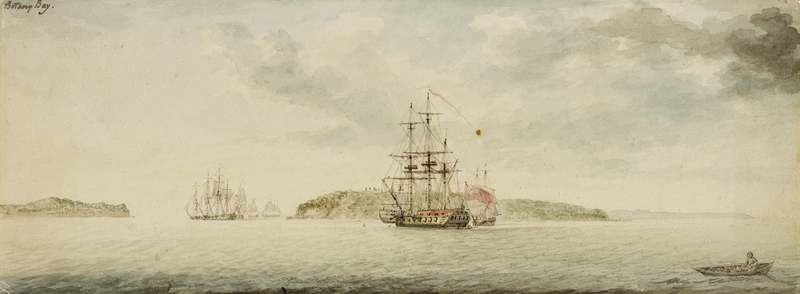 Botany Bay – 1788 New South Wales, drawn by Charles Gore Esq.
Botany Bay – 1788 New South Wales, drawn by Charles Gore Esq.
State Library of New South Wales. http://acms.sl.nsw.gov.au/item/itemLarge.aspx?itemID=826105
Header credit: Lowest life in London. Tom, Jerry, and Logic among the unsophisticated sons and daughters of Nature at ‘All Max’ in the East. Illustration by George Cruikshank (1792 – 1878). ©Trustees of the British Museum

